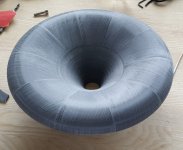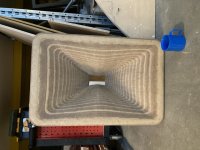I can "share" what I already have but I must warn you - it won't be easy to assemble. I haven't yet fully tested or proven the workability of these files myself. All of this is on your own responsibility, so if it doesn't work for some reason, don't blame me.
I would recommend to assemble the complete petal ring first, then attach it as a whole to to the base. Let me know how it turned out.
https://at-horns.eu/ext/CE360-EXPERIMENTAL.zip
I would recommend to assemble the complete petal ring first, then attach it as a whole to to the base. Let me know how it turned out.
https://at-horns.eu/ext/CE360-EXPERIMENTAL.zip
I've probably shown this already - it's how far I got with my own CE360 prints (well, it already has a primer sprayed on now). I need to measure it to confirm it behaves as expected - it still may be that the assembled prints are not accurate enough. I actually don't expect big problems, just need to be honest with you.

Attachments
I can "share" what I already have but I must warn you - it won't be easy to assemble. I haven't yet fully tested or proven the workability of these files myself. All of this is on your own responsibility, so if it doesn't work for some reason, don't blame me.
I would recommend to assemble the complete petal ring first, then attach it as a whole to to the base. Let me know how it turned out.
https://at-horns.eu/ext/CE360-EXPERIMENTAL.zip
Thankx
1-inch driver, 24 kHz, k=5 (not optimized)
How did you calculate the length of every "path"?
I'm trying to do something similar but not sure I'm doing it right...
That was still only a guess. I work on the algorithm now and if it works at all, I'll disclose it somewhere. Now it's a work in progress.
- What I'm a little worried about, is that the small variations across the throat wavefront, which would otherwise "average out" to a large degree (I suppose), could get amplified instead.
- What I'm a little worried about, is that the small variations across the throat wavefront, which would otherwise "average out" to a large degree (I suppose), could get amplified instead.
Last edited:
I guess I would hate it from the moment I would start doing it for a living. To me, audio = DIY, free and non-binding. I couldn't cope with the general dishonesty of the business (and with all the audiophiles...).Maybe you should be an audio engineer at some company. You have a talent for it.
Last edited:
You with your ATH and all this research, Kimmo Saunisto (with VituixCad), John Mulcahy (with REW) are fast forwarding DIY in to 21st century. These (all free) software with some 200€ of measuring equipment enable you to actually see and predict what you are doing. So, knowledge is free for the ones interested - very humane in my opinion and the only way to educate large masses of people.
If there was some user friendly FEA software for cabinet optimization (wall material, thickness and struts could be optimized for best performance) you'd be king of your castle
If there was some user friendly FEA software for cabinet optimization (wall material, thickness and struts could be optimized for best performance) you'd be king of your castle
Last edited:
Does someone know how to simply translate the directivity curves of the CE-series to the CEA-2034 style of graph?
I'd like to be able to compare the directivity curves to speakers measured by a NFS.
So for example, how to translate
https://at-horns.eu/img/CE360.png
into
https://www.audiosciencereview.com/...asurements-speaker-floor-standing-png.131666/
I'd like to be able to compare the directivity curves to speakers measured by a NFS.
So for example, how to translate
https://at-horns.eu/img/CE360.png
into
https://www.audiosciencereview.com/...asurements-speaker-floor-standing-png.131666/
You need to simulate the waveguide 180 degrees at 10 degree intervals both horizontal and vertical and then either export the data to VituixCAD where the responses can be combined as per 2034 requirements, or use bmc0's directivity script or make a VACS file that selects and processes the data as per the standard.
So no direct translation from the existing report but with a small amount of effort it can be done. mabat could probably incorporate it into the Ath report format without much difficulty if he thought it was useful.
If the device is axisymmetric then the H and V can be mirrored and the current Ath cirsym scripts already solve for 0 to 180 degrees making it easier.
So no direct translation from the existing report but with a small amount of effort it can be done. mabat could probably incorporate it into the Ath report format without much difficulty if he thought it was useful.
If the device is axisymmetric then the H and V can be mirrored and the current Ath cirsym scripts already solve for 0 to 180 degrees making it easier.
Arnandsway, the ATH data is demonstration a waveguide properties with perfect source and is not comparable to a full speaker system with real drivers producing a response. You can compare the sound power DI though, within the relevant bandwidth.
For some reason graphs on the internet won't show the DI scale explicitly. You can see the DI shape and smoothness though, if the DI is flat or rising or humbitybump and the scale can be visually approximated from the sound power and on axis response.
On another thread mabat hinted lumped compression driver model is coming to ATH, maybe comparable graphs are possible in the future.
For some reason graphs on the internet won't show the DI scale explicitly. You can see the DI shape and smoothness though, if the DI is flat or rising or humbitybump and the scale can be visually approximated from the sound power and on axis response.
On another thread mabat hinted lumped compression driver model is coming to ATH, maybe comparable graphs are possible in the future.
Last edited:
- Home
- Loudspeakers
- Multi-Way
- Acoustic Horn Design – The Easy Way (Ath4)

